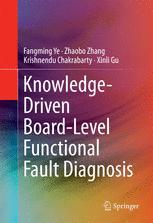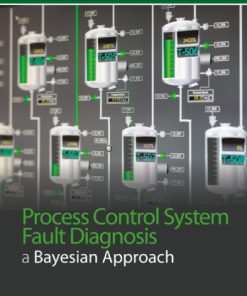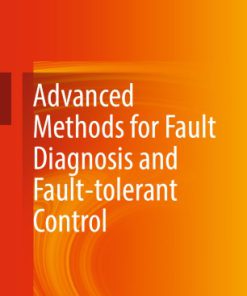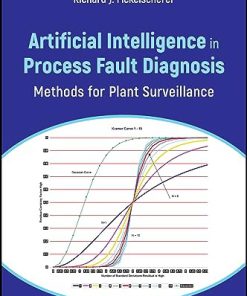Knowledge Driven Board Level Functional Fault Diagnosis 1st Edition by Fangming Ye, Zhaobo Zhang, Krishnendu Chakrabarty, Xinli Gu ISBN 3319402102 9783319402109
$50.00 Original price was: $50.00.$25.00Current price is: $25.00.
Knowledge Driven Board Level Functional Fault Diagnosis 1st Edition by Fangming Ye, Zhaobo Zhang, Krishnendu Chakrabarty, Xinli Gu – Ebook PDF Instant Download/Delivery: 3319402102, 9783319402109
Full download Knowledge Driven Board Level Functional Fault Diagnosis 1st Edition after payment
Product details:
ISBN 10: 3319402102
ISBN 13: 9783319402109
Author: Fangming Ye, Zhaobo Zhang, Krishnendu Chakrabarty, Xinli Gu
This book provides a comprehensive set of characterization, prediction, optimization, evaluation, and evolution techniques for a diagnosis system for fault isolation in large electronic systems. Readers with a background in electronics design or system engineering can use this book as a reference to derive insightful knowledge from data analysis and use this knowledge as guidance for designing reasoning-based diagnosis systems. Moreover, readers with a background in statistics or data analytics can use this book as a practical case study for adapting data mining and machine learning techniques to electronic system design and diagnosis. This book identifies the key challenges in reasoning-based, board-level diagnosis system design and presents the solutions and corresponding results that have emerged from leading-edge research in this domain. It covers topics ranging from highly accurate fault isolation, adaptive fault isolation, diagnosis-system robustness assessment, to system performance analysis and evaluation, knowledge discovery and knowledge transfer. With its emphasis on the above topics, the book provides an in-depth and broad view of reasoning-based fault diagnosis system design. • Explains and applies optimized techniques from the machine-learning domain to solve the fault diagnosis problem in the realm of electronic system design and manufacturing; • Demonstrates techniques based on industrial data and feedback from an actual manufacturing line; • Discusses practical problems, including diagnosis accuracy, diagnosis time cost, evaluation of diagnosis system, handling of missing syndromes in diagnosis, and need for fast diagnosis-system development.
Knowledge Driven Board Level Functional Fault Diagnosis 1st Table of contents:
1 Introduction
1.1 Introduction to Manufacturing Test
1.1.1 System and Tests
1.1.2 Testing in the Manufacturing Line
1.2 Introduction to Board-Level Diagnosis
1.2.1 Review of State-of-the-Art
1.2.2 Automation in Diagnosis System
1.2.3 New Directions Enabled by Machine Learning
1.2.4 Challenges and Opportunities
1.3 Outline of Book
References
2 Diagnosis Using Support Vector Machines (SVM)
2.1 Background and Chapter Highlights
2.2 Diagnosis Using Support Vector Machines
2.2.1 Support Vector Machines
2.2.2 SVM Diagnosis Flow
2.3 Multi-kernel Support Vector Machines and Incremental Learning
2.3.1 Multi-kernel Support Vector Machines
2.3.2 Incremental Learning
2.4 Results
2.4.1 Evaluation of MK-SVM-Based Diagnosis System
2.4.2 Evaluation of Incremental SVM-Based Diagnosis System
2.4.3 Evaluation of Incremental MK-SVM-Based Diagnosis System
2.5 Chapter Summary
References
3 Diagnosis Using Multiple Classifiers and Majority-Weighted Voting (WMV)
3.1 Background and Chapter Highlights
3.2 Artificial Neural Networks (ANN)
3.2.1 Architecture of ANNs
3.2.2 Demonstration of ANN-Based Diagnosis System
3.3 Comparison Between ANNs and SVMs
3.4 Diagnosis Using Weighted-Majority Voting
3.4.1 Weighted-Majority Voting
3.4.2 Demonstration of WMV-Based Diagnosis System
3.5 Results
3.5.1 Evaluation of ANNs-Based Diagnosis System
3.5.2 Evaluation of SVMs-Based Diagnosis System
3.5.3 Evaluation of WMV-Based Diagnosis System
3.6 Chapter Summary
References
4 Adaptive Diagnosis Using Decision Trees (DT)
4.1 Background and Chapter Highlights
4.2 Decision Trees
4.2.1 Training of Decision Trees
4.2.2 Example of DT-Based Training and Diagnosis
4.3 Diagnosis Using Incremental Decision Trees
4.3.1 Incremental Tree Node
4.3.2 Addition of a Case
4.3.3 Ensuring the Best Splitting
4.3.4 Tree Transposition
4.4 Diagnosis Flow Based on Incremental Decision Trees
4.5 Results
4.5.1 Evaluation of DT-Based Diagnosis System
4.5.2 Evaluation of Incremental DT-Based Diagnosis System
4.6 Chapter Summary
References
5 Information-Theoretic Syndrome and Root-Cause Evaluation
5.1 Background and Chapter Highlights
5.2 Evaluation Methods for Diagnosis Systems
5.2.1 Subset Selection for Syndromes Analysis
5.2.2 Class-Relevance Statistics
5.3 Evaluation and Enhancement Framework
5.3.1 Evaluation and Enhancement Procedure
5.3.2 An Example of the Proposed Framework
5.4 Results
5.4.1 Demonstration of Syndrome Analysis
5.4.2 Demonstration of Root-Cause Analysis
5.5 Chapter Summary
References
6 Handling Missing Syndromes
6.1 Background and Chapter Highlights
6.2 Methods to Handle Missing Syndromes
6.2.1 Missing-Syndrome-Tolerant Fault Diagnosis Flow
6.2.2 Missing-Syndrome-Preprocessing Methods
6.2.3 Feature Selection
6.3 Results
6.3.1 Evaluation of Label Imputation
6.3.2 Evaluation of Feature Selection in Handling Missing Syndromes
6.3.3 Comparison of Different Missing-Syndrome Handling Methods
6.3.4 Evaluation of Training Time
6.4 Chapter Summary
References
7 Knowledge Discovery and Knowledge Transfer
7.1 Background and Chapter Highlights
7.2 Overview of Knowledge Discovery and Transfer Framework
7.3 Knowledge-Discovery Method
7.4 Knowledge-Transfer Method
7.5 Results
7.5.1 Evaluation of Knowledge-Discover Method
7.5.2 Evaluation of Knowledge-Transfer Method
7.5.3 Evaluation of Hybrid Method
7.6 Chapter Summary
References
People also search for Knowledge Driven Board Level Functional Fault Diagnosis 1st:
knowledge-driven board-level functional fault diagnosis
functional failure path analysis
knowledge base failure
knowledge deficit diagnosis
knowledge deficit related to chf
Tags:
Fangming Ye,Zhaobo Zhang,Krishnendu Chakrabarty,Xinli Gu,Knowledge Driven,Board,Functional Fault,Diagnosis
You may also like…
Biology and other natural sciences - Plants: Agriculture and Forestry
Phytochemicals in Citrus: Applications in Functional Foods 1st Edition Xingqian Ye
Science (General)
Computers - Artificial Intelligence (AI)
Engineering - Automotive
Business & Economics - Responsibility and Business Ethics













